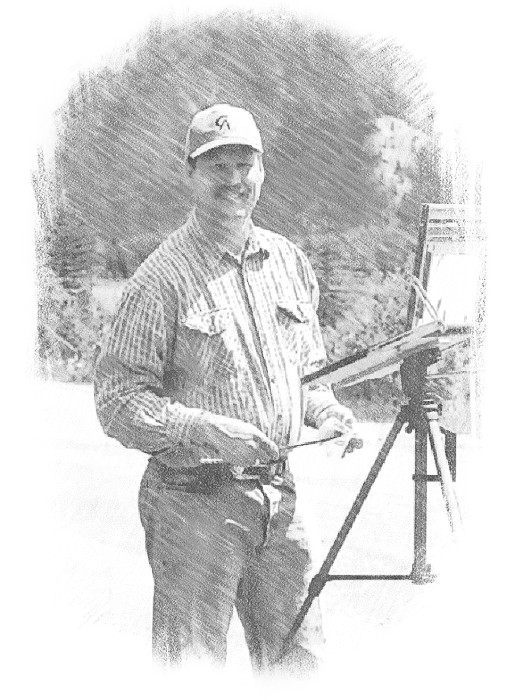
John Moyers, CA
(b. 1958)
Moyers grew up in Albuquerque, New Mexico, the son of Cowboy Artists of America painter, William Moyers. He had a natural affinity for art, and he grew up surrounded by paintings and sculpture during his formative years. He studied at the Laguna Beach School of Art and the California Institute for the Arts on a Walt Disney Studio scholarship. But it was in 1979 that Moyers was invited to attend a month-long workshop at the Okanagan Game Farm in British Columbia, led by another Cowboy Artist, Robert Lougheed. These workshops were one of few places where an artist could study traditional techniques for painting deer, musk ox, and other wild animals from real life. That workshop proved to be a turning point for Moyers and his art. The experience of painting ‘plein air’ day after day was a truly eye-opening experience in the way he approached a subject and in the way he captured it on canvas. The workshop was also where he met his future wife, Terri.
In the ensuing years Moyer’s career has progressed steadily, earning him recognition at the Prix de West Show at the National Cowboy Hall of Fame, Oklahoma City, and at the Masters of the American West Show at the Autry Museum of Western Heritage, Los Angeles. Having been a member of the Cowboy Artists of America since 1994 and served as president of the group, he also exhibits at the annual Cowboy Artists of America show at the Phoenix Art Museum. He has received top awards for more than seven years running at the CAA exhibitions in both oil and water soluble media.
He paints American Indians, cowboys, themes from Old Mexico and New Mexico, and landscapes. “I paint what excites me. Maybe for two months all I want to do is landscapes, then maybe Native Americans and then Mexican pieces.” Moyers also says, “The more you paint, the more comfortable you get with the process. Hopefully, I’m improving all the time.”
Moyers and his wife, Terri, and their son, Josh, live and paint in Santa Fe, New Mexico, while continuing to make annual pilgrimages to Canada where they never fail to be inspired by the rugged beauty of the northern landscapes of the American continent.
Source: John Moyers Fine Art
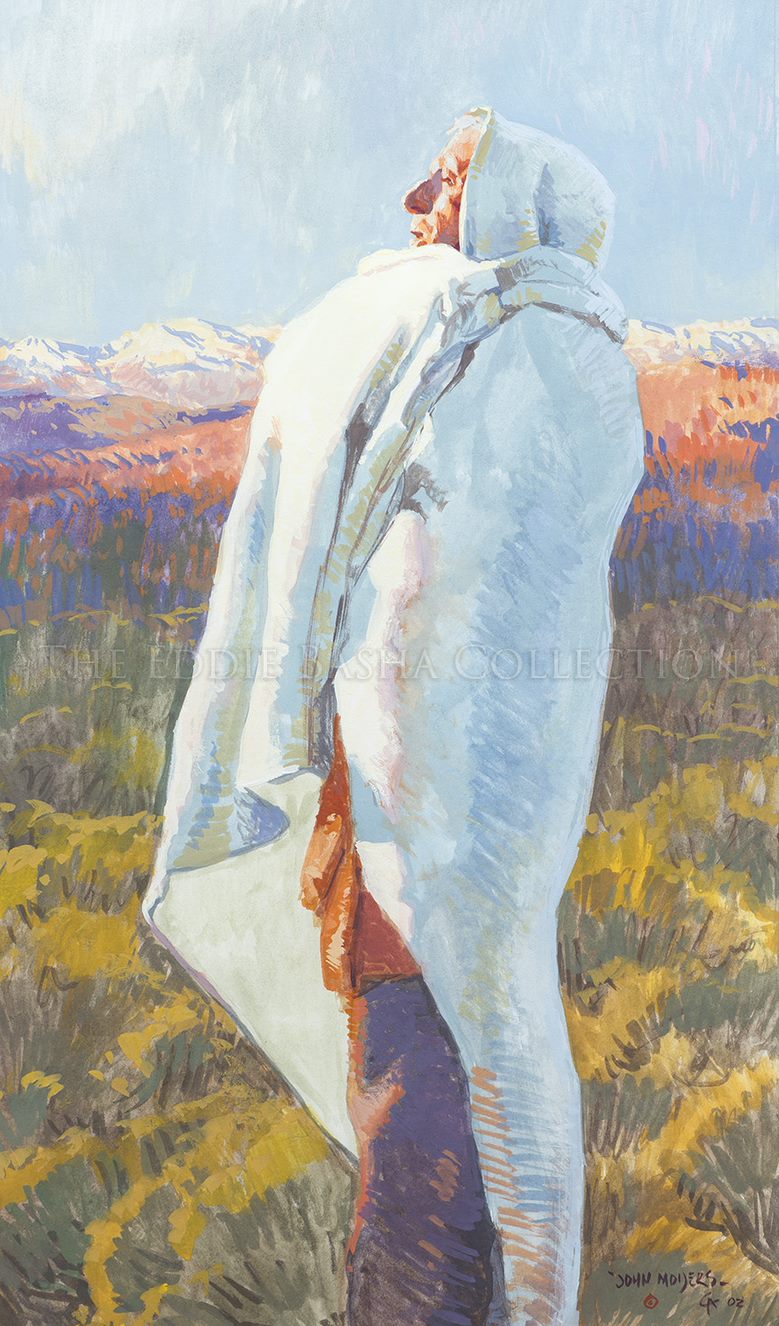
On the Edge of Winter
Artist: John Moyers, CA 1994-2011 (b. 1958)
Description: Gouache (2002) | Image Size: 24”h x 14”w; Framed Size: 4 ¾”h x 24 5/8”wpainting
Known as a realist painter, John Moyers often experiments with unique compositions and styles. In “On the Edge of Winter” Moyers presents a lone figure wrapped in a white blanket that contrasts with the vivid colors of the Southwestern landscape. While the painting is realistically rendered, it also highlights large forms and shapes which add an abstract quality to the artwork.
This gouache made its debut at the 37th Annual Cowboy Artists of America Show & Sale in 2002 at the Phoenix Art Museum. Moyers won the Artists’ Choice Award for his body of work that year. This award is especially meaningful as it is bestowed upon an artist by one’s peers.
Resting
Artist: John Moyers, CA 1994-2011 (b. 1958)
Description: Water Marker & Water Pen | Image Size: 16”h x 20”w; Framed Size: 21 ½”h x 25 ½”wdrawing
This depiction of a Mexican Revolutionary, mounted with his and his horse’s back to the viewer is a continuum of a series of drawings and paintings that John Moyers created of this historical period. The composition highlights Moyers’ skill at portraying his subjects and particular historical periods.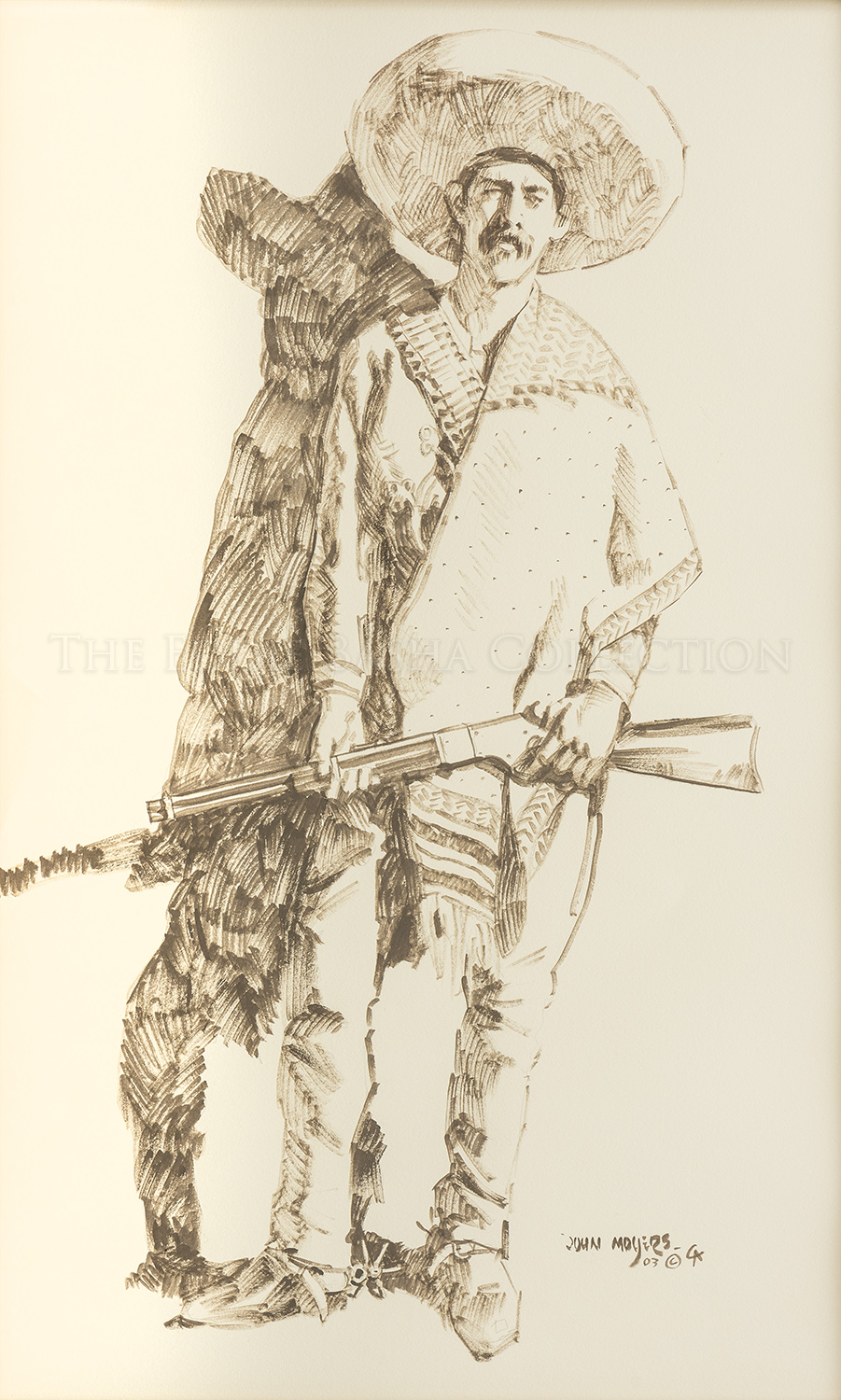
The Revolutionary
Artist: John Moyers, CA 1994-2011 (b. 1958)
Description: Dry Brush & Ink (2003) | Image Size: 15”w x 24”h; Framed Size: 23 ¾”w x 32 3/4”hdrawing
This drawing of a Mexican Revolutionary reflects John Moyers interest in that historic period (1910-1920). It is a subject that he has depicted in both large oil paintings and smaller drawings such as this one. Here Moyers presents his subject in traditional garb, wearing a serape, carrying a rifle and silver spurs. He is depicted in bright sunlight with a stark shadow behind him.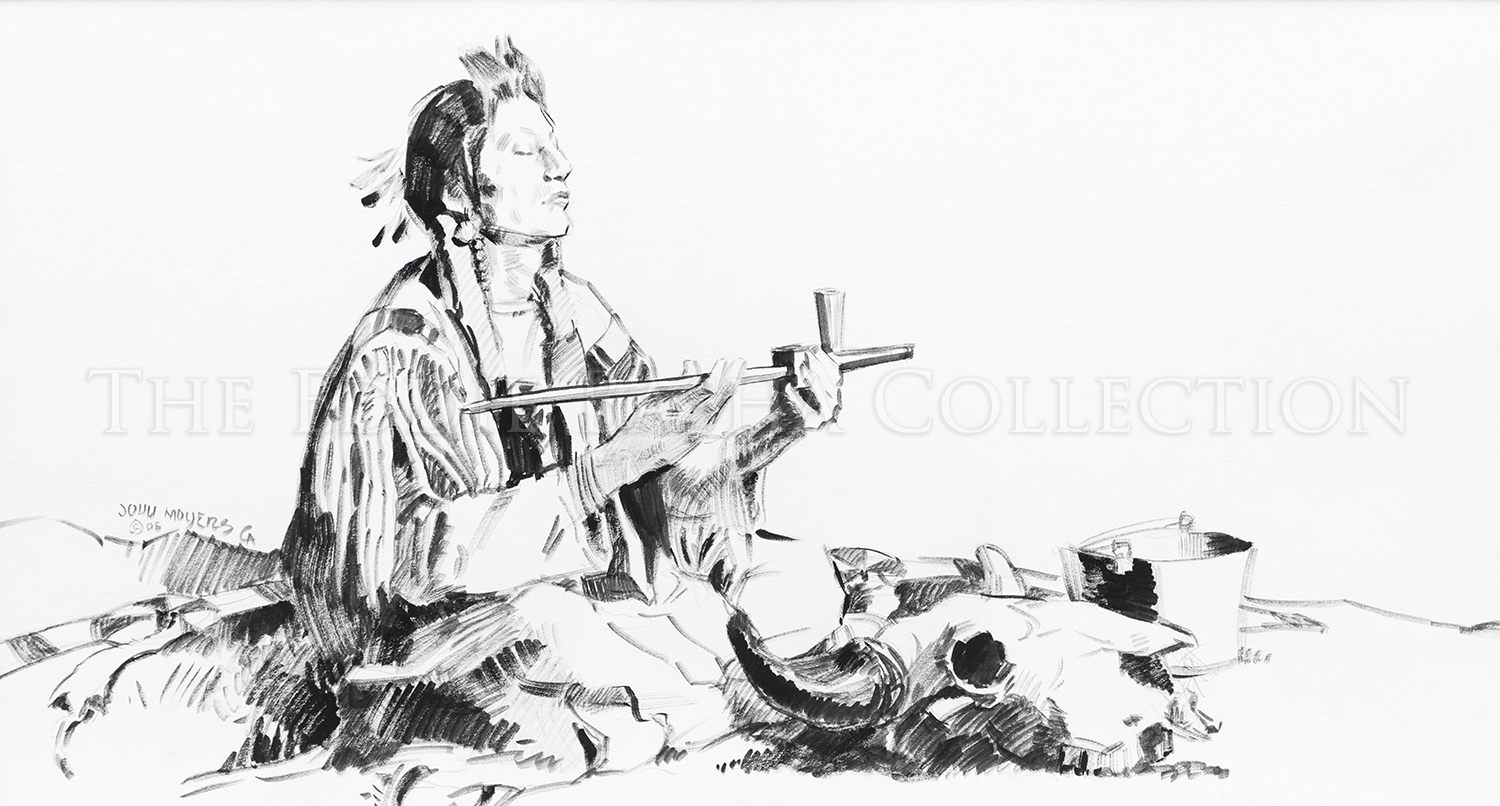
The Sacred Buffalo Skull
Artist: John Moyers, CA 1994-2011 (b. 1958)
Description: Dry Brush Ink (2005) | Image Size: 14”h x 26”w; Framed Size: 24 5/8”h x 36 5/8”wdrawing
Making its debut at the 40th Annual Cowboy Artists of America Show & Sale held at the Phoenix Art Museum in 2005, John Moyers crisp and realistic drawing “The Sacred Buffalo Skull” depicts a Plains Indian seated while holding a pipe and is likely engaged in a ceremony or practice that was designed to honor the buffalo for the sustenance it provided and to attract it back to the land where it once roamed.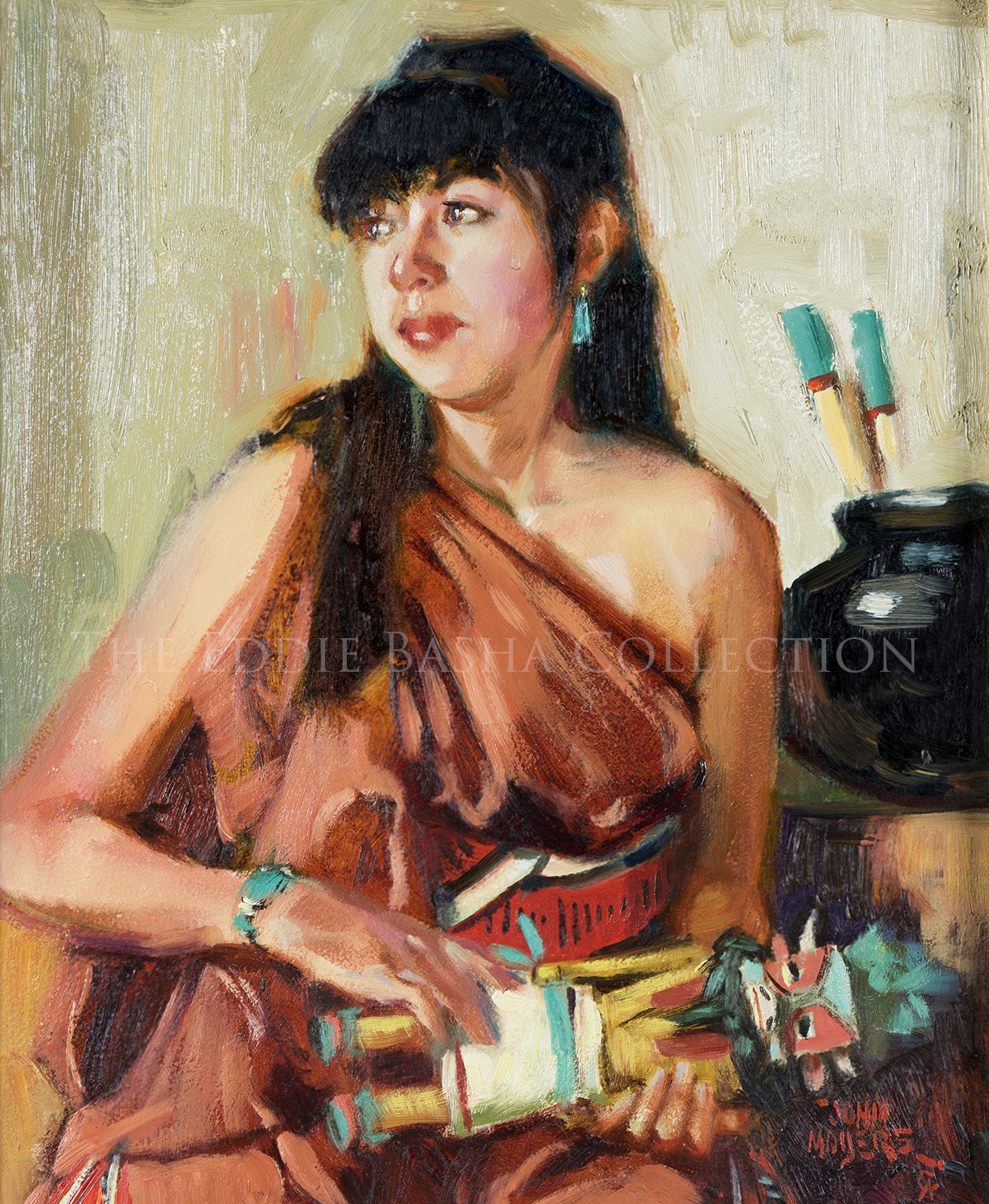
The Cow Kachina
Artist: John Moyers, CA 1994-2011 (b. 1958)
Description: Oil | Image Size: 12”h x 10”w; Framed Size: 18”h x 16”wpainting
This small, colorful portrait of a young Indian girl holding a kachina has a fresh feel to it and contains authentic details of clothing, traditional art such as her jewelry, the kachina and the black pot in the background. Moyers spent many years honing his talents as a plein air painter as a student of Robert Lougheed, a master of that technique. The quick, fluid brush strokes here, the casual pose of the young girl, and the deft handling of the kachina and other items are evidence of a technique learned in the field and applied to a studio setting.
Spirits in the Wind
Artist: John Moyers, CA 1994-2011 (b. 1958)
Description: Oil (1996) | Image Size: 48”h x 58”w; Framed Size: 57”h x 67 ½”wpainting
An artist can utilize many different elements and techniques to give a dramatic flair to a painting. In this large oil, John Moyers uses a single element, a billowing white fabric, draped over the shoulders of a Pueblo Indian to create a dynamic focal point that anchors the entire piece. The bright white cloth is placed in the center of the canvas on a horizontal plane that is deftly juxtaposed with several poles to the Indian’s left. The vertical and horizontal cross poles along with a wooden platform beneath the figure’s feet and a band of clouds behind him form a series of contrasting patterns. To amplify the brightness of the billowing cloth, the clouds behind are just a shade duller. The windswept cloth provides focus and adds a sense of movement and action to an otherwise still scene. The bright red breech cloth, orange shirt sleeve and golden tan leggings add dashes of color that enhance the painting’s visual interest. It is a masterful composition that entwines each element on the canvas into a cohesive whole. Moyer’s decision to place the cloth at center stage is key to the painting’s construct and its narrative.
“Spirits in the Wind” took home the silver medal in oil paintings at the 31st Annual Cowboy Artists of America Show & Sale in 1996 held at the Phoenix Art Museum.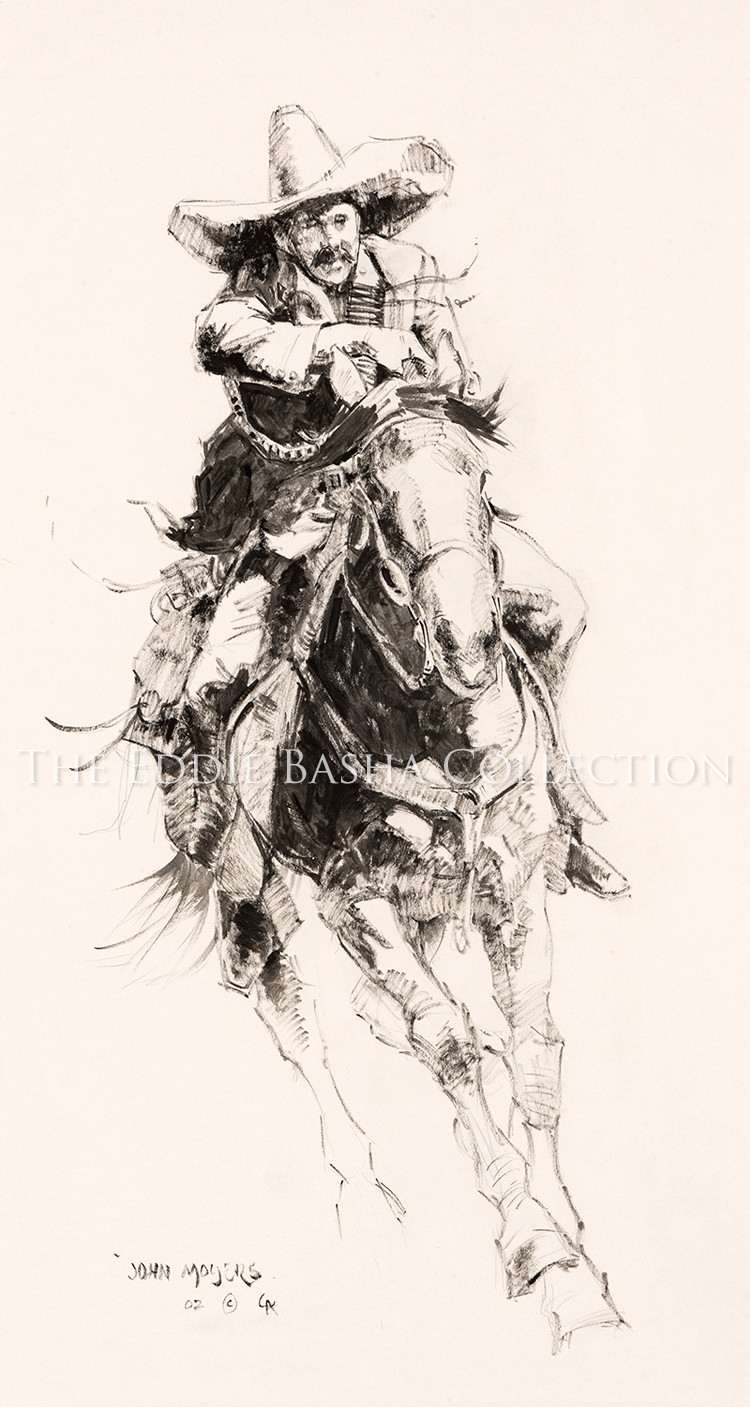
Making Time
Artist: John Moyers, CA 1994-2011 (b. 1958)
Description: Dry Brush Ink Drawing (2002) | Image Size: 26”h x 14”w; Framed Size: 36 5/8”h X 24 5/8”wdrawing
This meticulous, action-filled drawing of a Mexican rider galloping directly toward the viewer has a highly effective and fluid sense of movement that captures a palpable sense of speed. Its drama and adventure demonstrates Moyers’ proficiencies in both the ink/paper medium as well as his delivery of a great deal of information in a singular image. The horse is exceptionally well done, and the rider exudes a realistic and individual personality.
At the 2002 Cowboy Artists of America Exhibition & Sale at the Phoenix Art Museum, Moyers won the Artists’ Choice Award for his Body of Work and the Gold Medal in Drawing for “Making Time."
Moyers studied at the Laguna Beach School of Art, now renamed Laguna College of Art + Design and the California Institute for the Arts on a Walt Disney Studios scholarship. He and his family reside in Santa Fe, New Mexico.
This Day I Have Become Brave
Artist: John Moyers, CA 1994-2011 (b. 1958)
Description: Oil (2001) | Image Size: 50”h x 60”w; Framed Size: 58 ½”h X 68 ½”wpainting
Ostensibly this oil painting details a young man’s rite of passage; however, it transcends the subject matter alone. The atmosphere and tone set by the artist, John Moyers, reflects the spirit of the place and the people through his use of contrasting color, innovative composition and dynamic lighting. John attended both the Laguna College of Art + Design and the California Institute of the Arts.
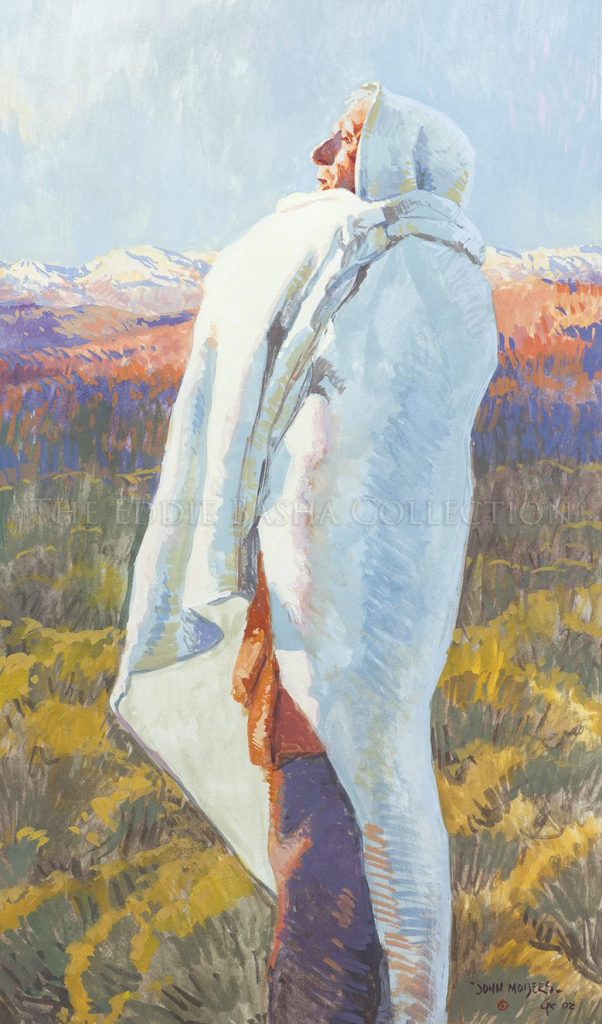 Gouache (2002) | Image Size: 24”h x 14”w; Framed Size: 4 ¾”h x 24 5/8”w
Gouache (2002) | Image Size: 24”h x 14”w; Framed Size: 4 ¾”h x 24 5/8”w Known as a realist painter, John Moyers often experiments with unique compositions and styles. In “On the Edge of Winter” Moyers presents a lone figure wrapped in a white blanket that contrasts with the vivid colors of the Southwestern landscape. While the painting is realistically rendered, it also highlights large forms and shapes which add an abstract quality to the artwork.
This gouache made its debut at the 37th Annual Cowboy Artists of America Show & Sale in 2002 at the Phoenix Art Museum. Moyers won the Artists’ Choice Award for his body of work that year. This award is especially meaningful as it is bestowed upon an artist by one’s peers.
On the Edge of Winter
Artist: John Moyers, CA 1994-2011 (b. 1958)
Known as a realist painter, John Moyers often experiments with unique compositions and styles. In “On the Edge of Winter” Moyers presents a lone figure wrapped in a white blanket that contrasts with the vivid colors of the Southwestern landscape. While the painting is realistically rendered, it also highlights large forms and shapes which add an abstract quality to the artwork.
This gouache made its debut at the 37th Annual Cowboy Artists of America Show & Sale in 2002 at the Phoenix Art Museum. Moyers won the Artists’ Choice Award for his body of work that year. This award is especially meaningful as it is bestowed upon an artist by one’s peers.
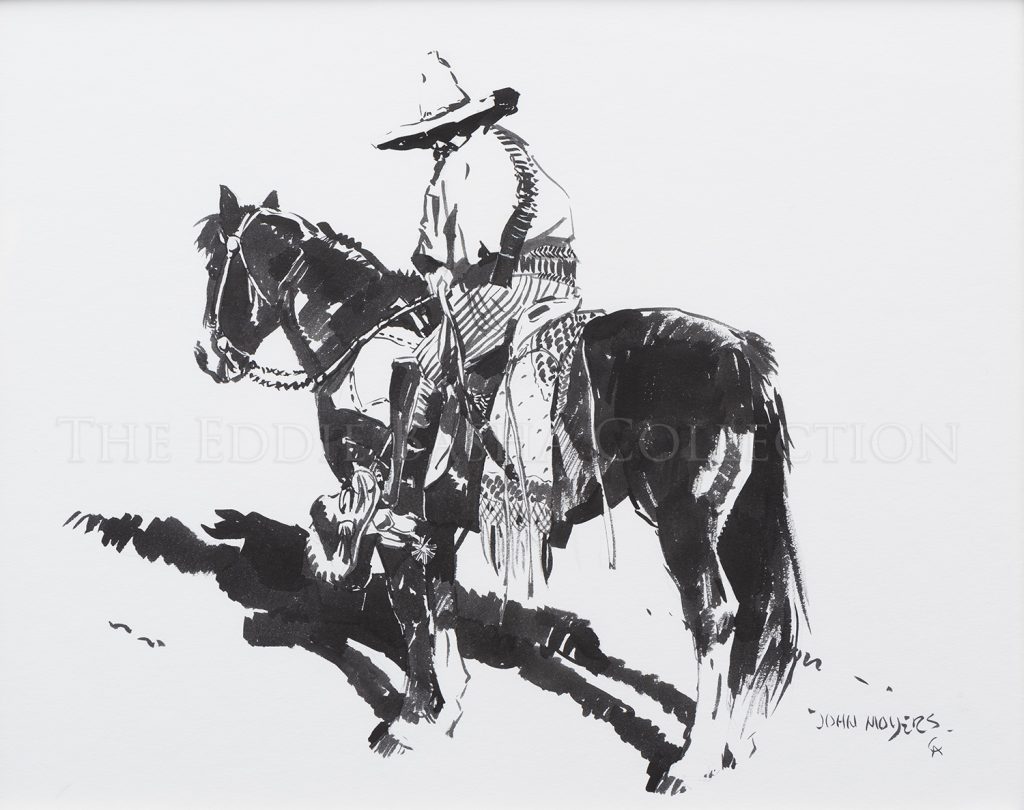 Water Marker & Water Pen | Image Size: 16”h x 20”w; Framed Size: 21 ½”h x 25 ½”w
Water Marker & Water Pen | Image Size: 16”h x 20”w; Framed Size: 21 ½”h x 25 ½”wThis depiction of a Mexican Revolutionary, mounted with his and his horse’s back to the viewer is a continuum of a series of drawings and paintings that John Moyers created of this historical period. The composition highlights Moyers’ skill at portraying his subjects and particular historical periods.
Resting
Artist: John Moyers, CA 1994-2011 (b. 1958)
This depiction of a Mexican Revolutionary, mounted with his and his horse’s back to the viewer is a continuum of a series of drawings and paintings that John Moyers created of this historical period. The composition highlights Moyers’ skill at portraying his subjects and particular historical periods.
 Dry Brush & Ink (2003) | Image Size: 15”w x 24”h; Framed Size: 23 ¾”w x 32 3/4”h
Dry Brush & Ink (2003) | Image Size: 15”w x 24”h; Framed Size: 23 ¾”w x 32 3/4”hThis drawing of a Mexican Revolutionary reflects John Moyers interest in that historic period (1910-1920). It is a subject that he has depicted in both large oil paintings and smaller drawings such as this one. Here Moyers presents his subject in traditional garb, wearing a serape, carrying a rifle and silver spurs. He is depicted in bright sunlight with a stark shadow behind him.
The Revolutionary
Artist: John Moyers, CA 1994-2011 (b. 1958)
This drawing of a Mexican Revolutionary reflects John Moyers interest in that historic period (1910-1920). It is a subject that he has depicted in both large oil paintings and smaller drawings such as this one. Here Moyers presents his subject in traditional garb, wearing a serape, carrying a rifle and silver spurs. He is depicted in bright sunlight with a stark shadow behind him.
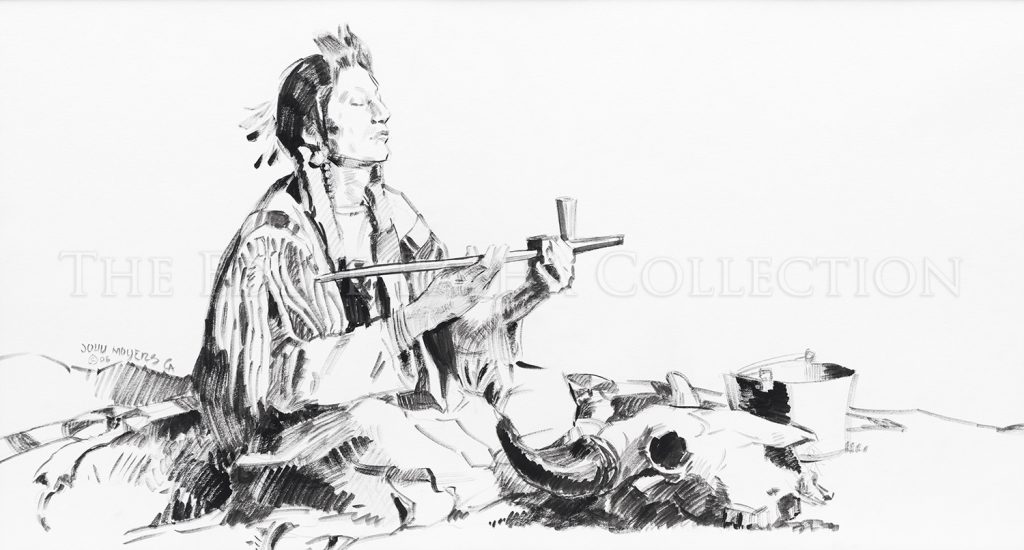 Dry Brush Ink (2005) | Image Size: 14”h x 26”w; Framed Size: 24 5/8”h x 36 5/8”w
Dry Brush Ink (2005) | Image Size: 14”h x 26”w; Framed Size: 24 5/8”h x 36 5/8”wMaking its debut at the 40th Annual Cowboy Artists of America Show & Sale held at the Phoenix Art Museum in 2005, John Moyers crisp and realistic drawing “The Sacred Buffalo Skull” depicts a Plains Indian seated while holding a pipe and is likely engaged in a ceremony or practice that was designed to honor the buffalo for the sustenance it provided and to attract it back to the land where it once roamed.
The Sacred Buffalo Skull
Artist: John Moyers, CA 1994-2011 (b. 1958)
Making its debut at the 40th Annual Cowboy Artists of America Show & Sale held at the Phoenix Art Museum in 2005, John Moyers crisp and realistic drawing “The Sacred Buffalo Skull” depicts a Plains Indian seated while holding a pipe and is likely engaged in a ceremony or practice that was designed to honor the buffalo for the sustenance it provided and to attract it back to the land where it once roamed.
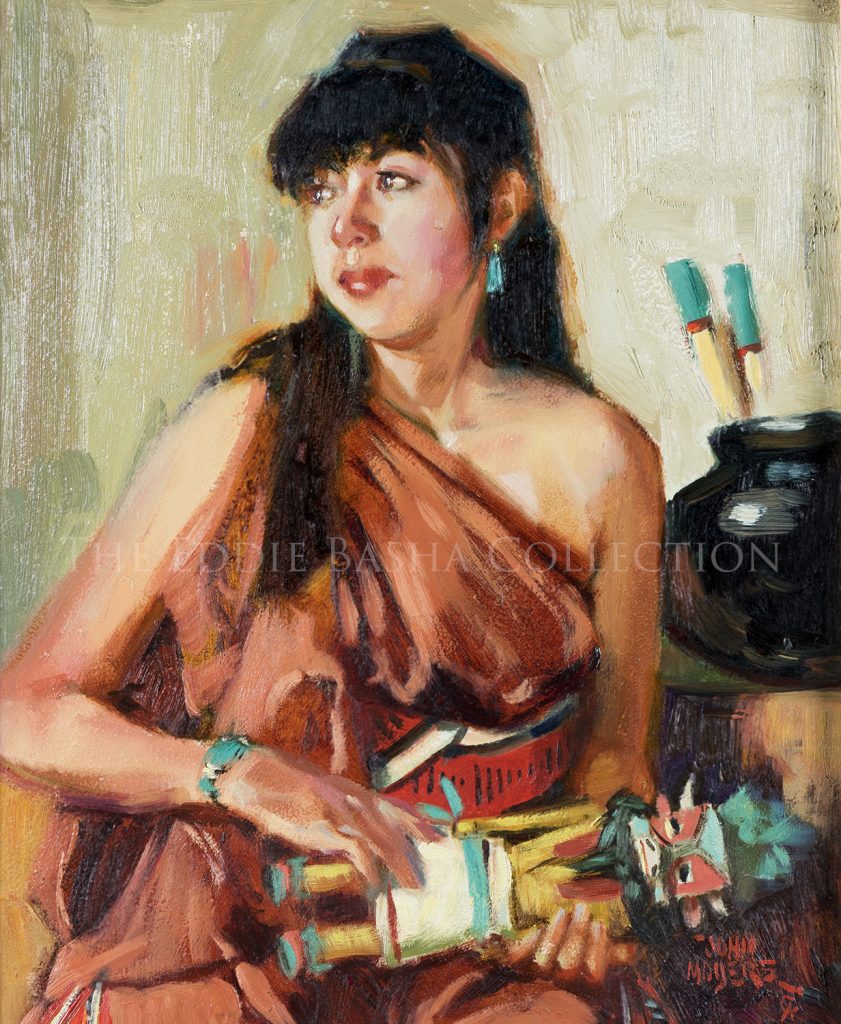 Oil | Image Size: 12”h x 10”w; Framed Size: 18”h x 16”w
Oil | Image Size: 12”h x 10”w; Framed Size: 18”h x 16”wThis small, colorful portrait of a young Indian girl holding a kachina has a fresh feel to it and contains authentic details of clothing, traditional art such as her jewelry, the kachina and the black pot in the background. Moyers spent many years honing his talents as a plein air painter as a student of Robert Lougheed, a master of that technique. The quick, fluid brush strokes here, the casual pose of the young girl, and the deft handling of the kachina and other items are evidence of a technique learned in the field and applied to a studio setting.
The Cow Kachina
Artist: John Moyers, CA 1994-2011 (b. 1958)
This small, colorful portrait of a young Indian girl holding a kachina has a fresh feel to it and contains authentic details of clothing, traditional art such as her jewelry, the kachina and the black pot in the background. Moyers spent many years honing his talents as a plein air painter as a student of Robert Lougheed, a master of that technique. The quick, fluid brush strokes here, the casual pose of the young girl, and the deft handling of the kachina and other items are evidence of a technique learned in the field and applied to a studio setting.
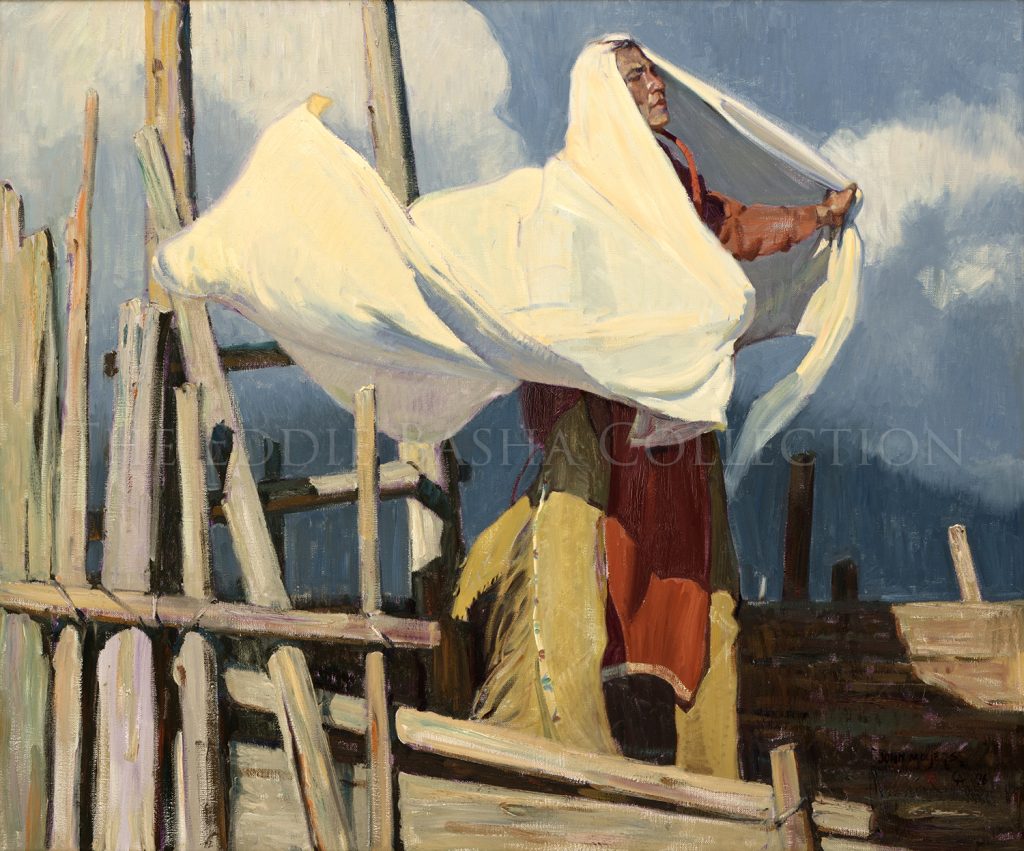 Oil (1996) | Image Size: 48”h x 58”w; Framed Size: 57”h x 67 ½”w
Oil (1996) | Image Size: 48”h x 58”w; Framed Size: 57”h x 67 ½”wAn artist can utilize many different elements and techniques to give a dramatic flair to a painting. In this large oil, John Moyers uses a single element, a billowing white fabric, draped over the shoulders of a Pueblo Indian to create a dynamic focal point that anchors the entire piece. The bright white cloth is placed in the center of the canvas on a horizontal plane that is deftly juxtaposed with several poles to the Indian’s left. The vertical and horizontal cross poles along with a wooden platform beneath the figure’s feet and a band of clouds behind him form a series of contrasting patterns. To amplify the brightness of the billowing cloth, the clouds behind are just a shade duller. The windswept cloth provides focus and adds a sense of movement and action to an otherwise still scene. The bright red breech cloth, orange shirt sleeve and golden tan leggings add dashes of color that enhance the painting’s visual interest. It is a masterful composition that entwines each element on the canvas into a cohesive whole. Moyer’s decision to place the cloth at center stage is key to the painting’s construct and its narrative.
“Spirits in the Wind” took home the silver medal in oil paintings at the 31st Annual Cowboy Artists of America Show & Sale in 1996 held at the Phoenix Art Museum.
Spirits in the Wind
Artist: John Moyers, CA 1994-2011 (b. 1958)
An artist can utilize many different elements and techniques to give a dramatic flair to a painting. In this large oil, John Moyers uses a single element, a billowing white fabric, draped over the shoulders of a Pueblo Indian to create a dynamic focal point that anchors the entire piece. The bright white cloth is placed in the center of the canvas on a horizontal plane that is deftly juxtaposed with several poles to the Indian’s left. The vertical and horizontal cross poles along with a wooden platform beneath the figure’s feet and a band of clouds behind him form a series of contrasting patterns. To amplify the brightness of the billowing cloth, the clouds behind are just a shade duller. The windswept cloth provides focus and adds a sense of movement and action to an otherwise still scene. The bright red breech cloth, orange shirt sleeve and golden tan leggings add dashes of color that enhance the painting’s visual interest. It is a masterful composition that entwines each element on the canvas into a cohesive whole. Moyer’s decision to place the cloth at center stage is key to the painting’s construct and its narrative.
“Spirits in the Wind” took home the silver medal in oil paintings at the 31st Annual Cowboy Artists of America Show & Sale in 1996 held at the Phoenix Art Museum.
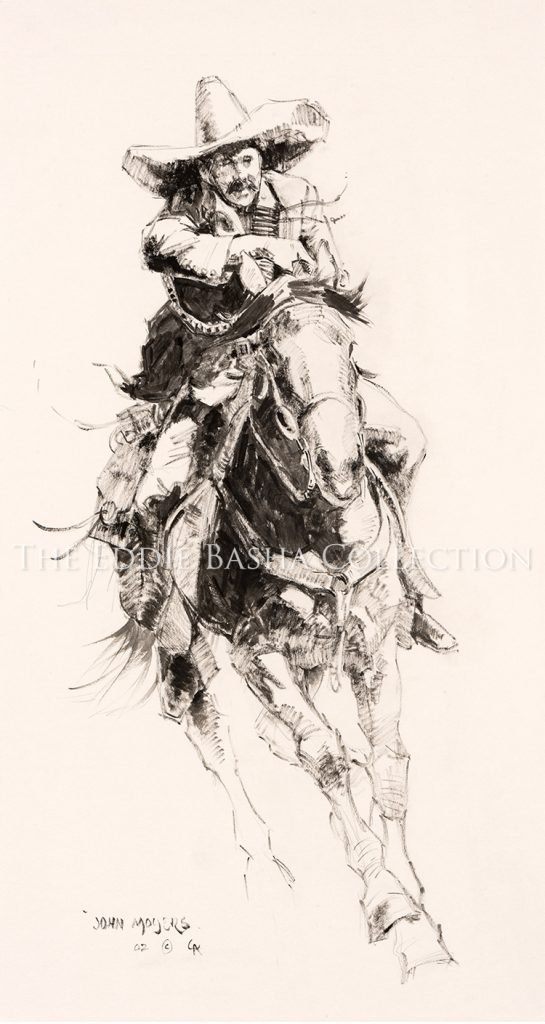 Dry Brush Ink Drawing (2002) | Image Size: 26”h x 14”w; Framed Size: 36 5/8”h X 24 5/8”w
Dry Brush Ink Drawing (2002) | Image Size: 26”h x 14”w; Framed Size: 36 5/8”h X 24 5/8”wThis meticulous, action-filled drawing of a Mexican rider galloping directly toward the viewer has a highly effective and fluid sense of movement that captures a palpable sense of speed. Its drama and adventure demonstrates Moyers’ proficiencies in both the ink/paper medium as well as his delivery of a great deal of information in a singular image. The horse is exceptionally well done, and the rider exudes a realistic and individual personality.
At the 2002 Cowboy Artists of America Exhibition & Sale at the Phoenix Art Museum, Moyers won the Artists’ Choice Award for his Body of Work and the Gold Medal in Drawing for “Making Time."
Moyers studied at the Laguna Beach School of Art, now renamed Laguna College of Art + Design and the California Institute for the Arts on a Walt Disney Studios scholarship. He and his family reside in Santa Fe, New Mexico.
Making Time
Artist: John Moyers, CA 1994-2011 (b. 1958)
This meticulous, action-filled drawing of a Mexican rider galloping directly toward the viewer has a highly effective and fluid sense of movement that captures a palpable sense of speed. Its drama and adventure demonstrates Moyers’ proficiencies in both the ink/paper medium as well as his delivery of a great deal of information in a singular image. The horse is exceptionally well done, and the rider exudes a realistic and individual personality.
At the 2002 Cowboy Artists of America Exhibition & Sale at the Phoenix Art Museum, Moyers won the Artists’ Choice Award for his Body of Work and the Gold Medal in Drawing for “Making Time."
Moyers studied at the Laguna Beach School of Art, now renamed Laguna College of Art + Design and the California Institute for the Arts on a Walt Disney Studios scholarship. He and his family reside in Santa Fe, New Mexico.
 Oil (2001) | Image Size: 50”h x 60”w; Framed Size: 58 ½”h X 68 ½”w
Oil (2001) | Image Size: 50”h x 60”w; Framed Size: 58 ½”h X 68 ½”wOstensibly this oil painting details a young man’s rite of passage; however, it transcends the subject matter alone. The atmosphere and tone set by the artist, John Moyers, reflects the spirit of the place and the people through his use of contrasting color, innovative composition and dynamic lighting. John attended both the Laguna College of Art + Design and the California Institute of the Arts.
This Day I Have Become Brave
Artist: John Moyers, CA 1994-2011 (b. 1958)
Ostensibly this oil painting details a young man’s rite of passage; however, it transcends the subject matter alone. The atmosphere and tone set by the artist, John Moyers, reflects the spirit of the place and the people through his use of contrasting color, innovative composition and dynamic lighting. John attended both the Laguna College of Art + Design and the California Institute of the Arts.